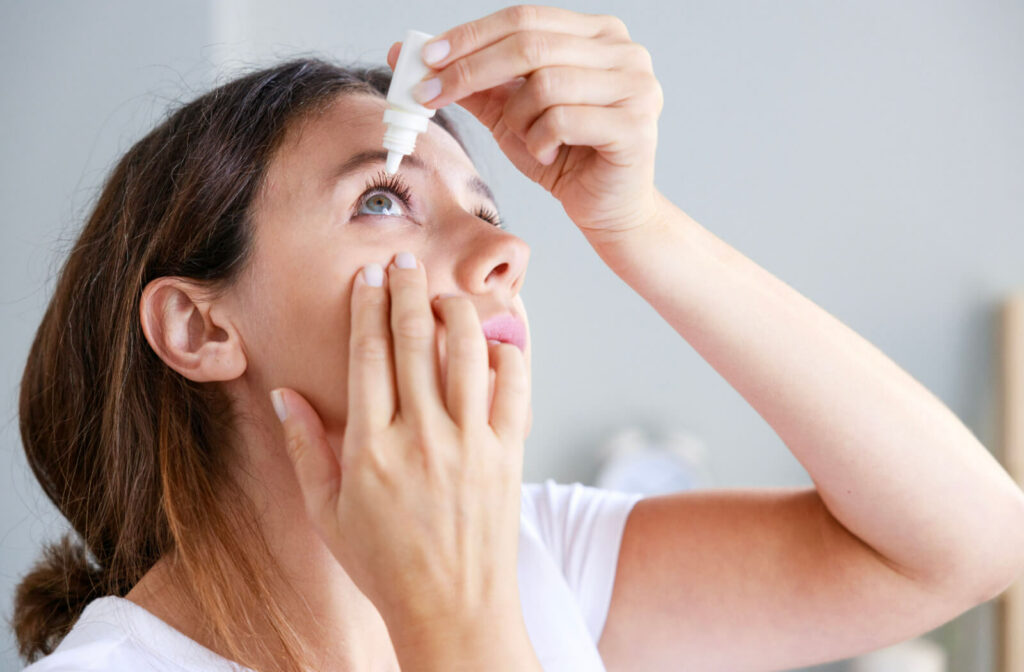Have you ever felt like there’s something stuck in your eyes? Where there’s redness, itchiness, or discomfort that just won’t go away? It was more than likely dry eye disease. Fortunately, you can reduce symptoms of this common eye condition with certain lifestyle changes, and eye drops can help bring relief. But if you haven’t used them before you might ask: how often should I use eye drops for dry eyes?
It depends on the severity of your dry eyes and the type of drops you’re using. If the drops have any kind of preservative in them, you should avoid using them more than four times a day, or less if your eyes are easily irritated. If there aren’t any preservatives and they aren’t irritating your eyes, you can use traditional lubricating eye drops as needed to find relief.
Don’t forget to read the label, as many bottles will be marked with their specific safe limit!
What Is Dry Eye Disease?
Dry eye disease, also called dry eye or dry eye syndrome, is an extremely common condition, especially in Calgary. It occurs when your eyes produce too few tears or tears that are poor quality. It can leave your eyes vulnerable, dry, and exposed to the air.
It often feels like there’s a piece of sand trapped under your eyelid, or like there’s an itch on the surface of your eye. Dry eye disease can cause:
- Redness and swelling
- A burning or stinging sensation
- Sensitivity to light
- Watery eyes, as the eye struggles to flush the dry area with low quality tears
- Blurry or distorted vision
- Frequent blinking of eye rubbing
It’s caused by a problem with your tear fluid production. It could be that your eye just can’t produce enough tears to meet demand. In other situations, the tears being produced are evaporating too quickly, leaving the eye vulnerable. Fortunately, this condition is highly treatable.
How Is Dry Eye Treated?
Most forms of dry eye therapy aim to address the cause of the condition. These methods often involve making changes to your environment, changing your diet, drinking more water, and other such lifestyle adjustments.
But for many people, dry eye is a chronic condition that requires ongoing management. In these situations, optometrists will often recommend eye drops. These can help bring you temporary relief from your dry eyes.
How Do Eye Drops Help?
It can help to think of eye drops like they’re mimicking the natural tears your eyes produce. This is why lubricating eye drops are often called “artificial tears.” They help to:
- Moisturize the surface of the eyes, reducing redness and discomfort
- Create a protective layer that helps slow the evaporation of natural tears
- Dilute and wash away irritants and allergens that can cause or worsen dryness
- Supplement the eye’s natural tear film and improve its stability
- Promote healing of the eye surface in cases where dryness has led to minor abrasions or erosion
They stimulate and reinforce your natural tears to protect your eyes. Depending on the type of eye drop you’re using, they also might contain ingredients that can help improve your overall tear production.
How Often Should I Use Eye Drops?
First-time eye drop users often wonder how often they’re supposed to use them. Are they supposed to be used once a day, once an hour, or every few minutes?
Unfortunately, the answer is: it depends. Several factors come into play that can determine the answer for you, like how severe your dry eye disease is or the type of drops you’re using.
If you’re using a standard lubricating eye drop, you should be able to use it as often as you need. If it helps bring you relief and isn’t causing further irritation, you’re likely fine—but make sure you read the label on the bottle first, as each brand may have specific guidelines on frequency of use.
It becomes a little more complicated if the bottle has any type of preservative inside. These preservatives are designed to keep bacteria from infecting the solution, which helps to keep your eyes clean and sterile from outside contaminants.
But many people find that those helpful preservatives also make the eye drops much harsher on their eyes. Most optometrists don’t recommend using this type more than four times a day since it can cause irritation when your eyes are already sensitive and inflamed.
If you’re confused or unsure, it can help to reach out to your optometrist. Remember: they’re an eye care professional, and they’re there to help!
Where to Get Eye Drops for Dry Eye
If you’re experiencing dry eye disease, come visit us at Eye on Evanston in Calgary. We can provide a proper diagnosis, and we’re here to recommend appropriate treatment to find you relief. Remember, dry eye is manageable with the right care and treatment, so book an appointment with us today!





